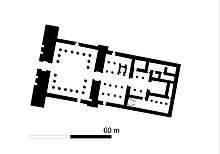Sanam, Sudan

Plan of the temple at Sanam
Sanam is a modern village in Sudan.
Here were found the remains of an ancient town which flourished mainly in the Napatan Period. These are perhaps the remains of Napata, the capital of the Kushite empire from about 800 to 300 BC. Parts of the town were excavated in 1912 to 1913 by Francis Llewellyn Griffith. He found the remains of a badly preserved temple and of a building he called treasury. Most importantly, he excavated a big cemetery belonging to the inhabitants of the town. This is one of the few so far excavated cemeteries of this period belonging to "common" people.[1]
References
- ↑ Angelika Lohwasser: The Kushite Cemetery of Sanam: A Non-royal Burial Ground of the Nubian Capital, c. 800-600 BC, London 2010 ISBN 978-1-906137-16-8
Coordinates: 18°29′N 31°49′E / 18.483°N 31.817°E
This article is issued from Wikipedia - version of the 3/11/2015. The text is available under the Creative Commons Attribution/Share Alike but additional terms may apply for the media files.